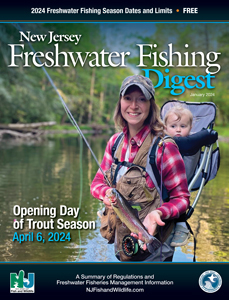Stocking Programs
Trout Stocking
Raised with pride at NJDEP Fish & Wildlife’s Pequest Trout Hatchery.
Spring
- Over 180,000 released for Opening Day — April 6, 2024
- Over 570,000 Rainbow Trout (avg. 10.5 inches)
- Spring stocking begins March 18, 2024
- 6,000–7,000 breeders 15–26 inches (3–7 pounds)
- 85 streams and 87 lakes and ponds stocked statewide
- All 21 counties stocked
- Most waterbodies stocked at least 3 times
- Stocking continues for seven weeks following Opening Day!
Fall
- Fall Stocking begins October 8, 2024
- All large, two year old trout, measuring up to 16 inches
- 21,000 trout stocked
- 36 streams, lakes, and ponds
- Up to 1,000 breeders, averaging 20 inches
- Great fishing till next spring!
Winter
- November 25 and 26, 2024
- All large two year olds, measuring up to 16 inches
- Over 4,000 trout
- 18 lakes and ponds
- Great fishing all winter long!
NEW Trout Stocking Hotline: 609-322-9524
Spring Trout Stocking Schedule — 2024
To view New Jersey's 2024 trout stocking schedule, go to dep.nj.gov/wp-content/uploads/njfw/spring-trout-allocations-2024.pdf
Hatchery-Supported Fisheries
Courtesy of the Hackettstown State Fish Hatchery 2023 production highlights.
Muskellunge: 10–12" (10,095)
- Cooper River Park (250 Tiger Muskie)
- DOD Lake (250 Tiger Muskie)
- Echo Lake Reservoir (420 Pure Strain)
- Furnace Lake (10 Pure & 100 Tiger)
- Greenwood Lake (2,922 Pure & 1,500 Tiger)
- Lake Hopatcong (2,693 Tiger Muskie)
- Lake Musconetcong (660 Tiger Muskie)
- Little Swartswood Lake (150 Tiger Muskie)
- Mercer Lake (420 Pure Strain)
- Monksville Reservoir (505 Tiger Muskie)
- Mountain Lake (125 Pure Strain)
Northern Pike: 6.5" (21,448)
- Budd Lake (1,885)
- Farrington Lake (2,984)
- Passaic River (3,422)
- Pompton Lake (3,060)
- Pompton River (2,456)
- Spruce Run Reservoir (6,450)
Surplus stocked in: Cranberry and Deal Lake
Walleye: 2" (184,792); 4" (37,303)
- Canistear Reservoir (7,000)
- Greenwood Lake (38,620)
- Lake Hopatcong (52,587)
- Monksville Reservoir (10,800)
- Swartswood Lake (9,926)
Surplus stocked in: Delaware River
Hybrid Striped Bass: 4" (46,470)
- Lake Hopatcong (26,212)
- Manasquan Reservoir (7,355)
- Spruce Run Reservoir (12,903)
Landlocked Salmon: 15" (2,880)
- Lake Aeroflex (505)
- Merrill Creek Reservoir (650)
- Tilcon Lake (450)
- Wawayanda Lake (1,275)
Channel Catfish: 6" (12,695)
- ten waters
Channel Catfish: 12" (10,530)
- sixty-seven waters
Channel Catfish: 20" (383)
- five waters
Plus thousands of Largemouth and Smallmouth Bass, Black Crappie, Bluegill, Fathead Minnows, and Golden Shiners in over 100 waterbodies throughout the state!
Raised with pride at NJDEP Fish & Wildlife's Hackettstown State Fish Hatchery.
Warmwater Fish Stocking List
To view New Jersey's warmwater fish stocking list, go to dep.nj.gov/njfw/fishing/freshwater/the-charles-o-hayford-state-fish-hatchery-in-hackettstown/#summaries
Fish Stocking Do's and Don'ts
Why should I get a Fish Stocking Permit?
It is the law! Before you consider stocking any fish in New Jersey, you must first obtain a fish stocking permit from NJDEP Fish & Wildlife. It does not matter whether the pond is public or private, connected to, or isolated from, a neighboring water, or if the waterbody is stocked by the state or a private club. A fish stocking permit is always required.
An application and information can be found at dep.nj.gov/njfw/fishing/freshwater/freshwater-fisheries-permits. The application fee is only $2.
Only approved hatcheries will be authorized for stocking. Hatcheries are required to submit annual fish health information, thus minimizing the potential for the spread of disease.
Fish Stocking Do’s
- Do establish your stocking goal, whether it is to supplement an existing population, create a unique opportunity or restore a fishery (dredging or dam repair project).
- Do know your waterbody. Most fish require particular conditions, so understand your waterbody’s habitat and water quality. Factors to consider include waterbody size, depth and substrate, and water temperature, oxygen level, pH and flow.
- Do get permission from the waterbody owner, as their signature is required on the application.
- Do avoid delays in the processing of your application by first reviewing the nine simple guidelines listed at dep.nj.gov/wp-content/uploads/njfw/fisheries_permitapp_info.pdf
Fish Stocking Don’ts
- Don’t purchase fish from a hatchery without obtaining a fish stocking permit.
- Don’t transport fish from one waterbody to another.
- Don’t assume your pond needs to be stocked, as most waters do not require stocking.
- Don’t stock an invasive species dep.nj.gov/njfw/fishing/freshwater/aquatic-invasive-species
- Don’t assume common game species are harmless. Even they can cause ecological harm if introduced into the wrong locations.
- Don’t release pet aquarium fish into a local waterway.

